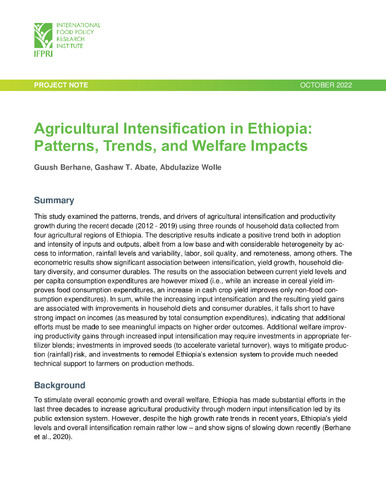Agricultural intensification in Ethiopia: Patterns, trends, and welfare impacts
Abstract
This study examined the patterns, trends, and drivers of agricultural intensification and productivity growth during the recent decade (2012 - 2019) using three rounds of household data collected from four agricultural regions of Ethiopia. The descriptive results indicate a positive trend both in adoption and intensity of inputs and outputs, albeit from a low base and with considerable heterogeneity by access to information, rainfall levels and variability, labor, soil quality, and remoteness, among others. The econometric results show significant association between intensification, yield growth, household dietary diversity, and consumer durables. The results on the association between current yield levels and per capita consumption expenditures are however mixed (i.e., while an increase in cereal yield improves food consumption expenditures, an increase in cash crop yield improves only non-food consumption expenditures). In sum, while the increasing input intensification and the resulting yield gains are associated with improvements in household diets and consumer durables, it falls short to have strong impact on incomes (as measured by total consumption expenditures), indicating that additional efforts must be made to see meaningful impacts on higher order outcomes. Additional welfare improv-ing productivity gains through increased input intensification may require investments in appropriate fer-tilizer blends; investments in improved seeds (to accelerate varietal turnover), ways to mitigate production (rainfall) risk, and investments to remodel Ethiopia’s extension system to provide much needed technical support to farmers on production methods.

